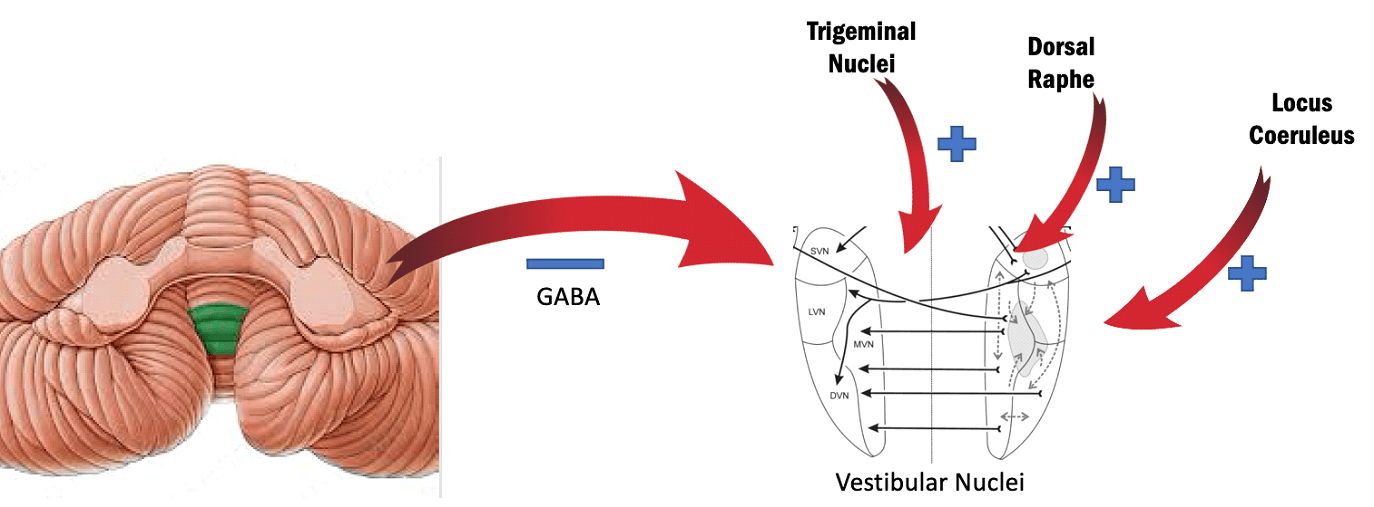GABA Agonists to be Considered in the Treatment of Vestibular Migraine
Treatment of Vestibular Migraine (VM) requires general control of hyperactivity in the vestibular nuclei. This hyperactivity can result from reciprocal connections between the vestibular nuclei and the trigeminal nucleus, the dorsal raphe nucleus and the locus coeruleus, all of which may be hypermetabolic in migraine. Hyperactivity in these various sites can be treated in many patients with traditional migraine preventive medications. In addition to control of this general migraine hyperactivity, patients with vestibular migraine often respond well to enhancement of inherent inhibitory tone of the cerebellar vermis on the vestibular nuclei that is mediated by the inhibitory transmitter gamma-aminobutyric acid (GABA). Therefore, the use of GABA-ergic medications deserves special consideration in this patient group.
GABA plays a crucial role in the coordination of the central vestibular pathways, contributing to vestibular compensation. The GABAergic neurons in the vestibular nuclei (VN) participate in vital vestibular sensory processing, allowing for multisensory and multimodal vestibular processing. GABA functions as a key neurotransmitter in the VN involved in maintaining and rehabilitating vestibular dynamic and static symptoms. Additionally, GABAergic neurons in the VN have reciprocal neural connectivity with other brain regions, such as the ipsilateral 3N and contralateral 6N, and are involved in regulating extraocular muscle movement, mediating vestibular reflexes, and regulating autonomic function. The cerebellar vermis provides powerful GABAergic inhibitory input to the vestibular nuclei, which is necessary for compensation. Therefore, GABA plays a pivotal role in the vestibular nucleus and cerebellum connections, contributing to the maintenance and regulation of various vestibular functions [1][2][3][4][5].

Citations:
[1] https://www.sciencedirect.com/science/article/abs/pii/S0301008204002072
[2] https://www.ncbi.nlm.nih.gov/pmc/articles/PMC2910079/
[3] https://www.frontiersin.org/articles/10.3389/fnins.2022.982596/full
[4] https://www.ncbi.nlm.nih.gov/pmc/articles/PMC9459096/
[5] https://www.sciencedirect.com/topics/neuroscience/medial-vestibular-nucleus
Medications that up-regulate or enhance GABA activity in the central nervous system (CNS) can help to increase cerebellar regulation of abnormal activity in the vestibular nuclei but offer several other benefits, including:
1. Treatment of Seizures: GABA agonists such as valproic acid, pregabalin, and gabapentin are used as anticonvulsants[1][3].
2. Mood Stabilization: Valproic acid, a GABA analog, can be used for mood instability due to the enhancement of GABA concentrations[1].
3. Anxiolytic Effects: GABAergic medications, including benzodiazepines and GABA analogs, are prescribed to reduce anxiety and induce relaxation[1][3].
4. Pain Management: GABA analogs like gabapentin and pregabalin are used to treat neuropathic pain and fibromyalgia[1][3].
5. Sedation and Sleep Regulation: GABA agonists can help induce sleep and regulate the sleep-wake cycle[3].
It is important to note that while these medications offer various benefits, they can also lead to CNS depression and other side effects, and their use should be carefully monitored [1].
Citations:
[1] https://www.ncbi.nlm.nih.gov/books/NBK526124/
[2] https://www.statnews.com/2016/07/22/brain-gaba-drugs/
[3] https://mhanational.org/what-gaba
[4] https://www.sciencedirect.com/topics/medicine-and-dentistry/gaba-reuptake-inhibitor
[5] https://www.ncbi.nlm.nih.gov/pmc/articles/PMC3012402/
The following medications up-regulate GABA activity in various ways and deserve consideration in the treatment of vestibular migraine patients who do not respond to general migraine preventive therapy:
Venlafaxine
Venlafaxine has been found to affect GABA levels in the brain. A study demonstrated that venlafaxine treatment was nonsignificantly associated with increased GABA levels compared to placebo[1]. This indicates that venlafaxine may have an impact on GABA activity in the brain that may explain it’s unique usefulness in vestibular migraine treatment compared to other serotonin active drugs.
Citations:
[1] https://pubmed.ncbi.nlm.nih.gov/16075286/
[2] https://www.drugs.com/drug-interactions/effexor-with-gabapentin-2296-1524-1147-0.html
[3] https://connect.mayoclinic.org/discussion/tips-on-minimising-withdrawal-symptoms-from-effexor-aka-venlafaxine/?pg=290
[4] https://pubmed.ncbi.nlm.nih.gov/22245561/
[5] https://www.sciencedirect.com/science/article/pii/000689939090111N
Propranolol
Propranolol has been found to affect GABA. Research suggests that propranolol treatment can stimulate GABA-benzodiazepine receptor coupling, leading to an increase in GABA-stimulated diazepam binding[1][3]. Additionally, chronic administration of propranolol has been shown to increase GABA content, synthesis, and turnover rate in selected brain areas, indicating an influence on the functional state of the GABAergic system[4]. Therefore, there is evidence to support the notion that propranolol affects GABA activity in the brain. It, therefore, may have a specific role in the treatment of vestibular migraine.
Citations:
[1] https://www.sciencedirect.com/science/article/pii/0306362388901607
[2] https://www.sciencedirect.com/science/article/pii/0306362388901607/pdf?md5=6e5fcc31a3aa8474d4da80f03bfc1333&pid=1-s2.0-0306362388901607-main.pdf
[3] https://pubmed.ncbi.nlm.nih.gov/3410277/
[4] https://pubmed.ncbi.nlm.nih.gov/1510697/
[5] https://www.ncbi.nlm.nih.gov/books/NBK526124/
Topiramate
Topiramate affects GABA. Research has shown that topiramate increases cerebral GABA concentrations acutely in healthy individuals and also raises brain GABA levels in epilepsy patients. This effect is thought to contribute to the drug's anticonvulsant properties[2][4]. Additionally, topiramate has been found to enhance GABA-mediated chloride flux and GABA-evoked chloride currents in the brain, which may contribute to its ability to increase seizure threshold[3]. Therefore, topiramate is known to modulate GABA levels in the brain, which is linked to its therapeutic effects. Topiramate is very effect in general management of chronic migraine and may exhibit its effect on vestibular migraine by this effect alone. Its specific usefulness in vestibular migraine specifically has not been demonstrated but deserves consideration even in patients without headache.
Citations:
[1] https://www.drugs.com/drug-interactions/gabapentin-with-topamax-1147-0-2216-1469.html
[2] https://pubmed.ncbi.nlm.nih.gov/11839834/
[3] https://pubmed.ncbi.nlm.nih.gov/9332882/
[4] https://onlinelibrary.wiley.com/doi/full/10.1046/j.1528-1157.2001.18800.x
[5] https://www.sciencedirect.com/topics/chemistry/gaba-uptake-inhibitor
Gabapentin
Gabapentin affects the GABA system in the brain. Although it does not directly bind to GABA receptors or act as a GABA agonist, it has been found to increase GABA synthesis and release. Gabapentin modulates the action of the GABA synthetic enzyme, glutamic acid decarboxylase (GAD), and increases non-synaptic GABA responses from neuronal tissues in vitro[2]. Glutamate decarboxylase is an enzyme involved in GABA synthesis, and increase GABA turnover in the brain[1]. Therefore, while gabapentin does not directly interact with GABA receptors, it exerts its effects by influencing GABA synthesis and release, which is relevant to its therapeutic use in conditions such as epilepsy and neuropathic pain[4]. The usefulness of gabapentin in vestibular migraine has not been demonstrated but deserves consideration.
Citations:
[1] https://www.ncbi.nlm.nih.gov/pmc/articles/PMC3499716/
[2] https://pubmed.ncbi.nlm.nih.gov/9686247/
[3] https://www.sciencedirect.com/topics/neuroscience/gabapentin
[4] https://my.clevelandclinic.org/health/drugs/21561-gabapentin
[5] https://www.sciencedirect.com/science/article/pii/000689939291038G
Pregabalin
Pregabalin, a structural analogue of GABA, does not directly bind to GABA receptors or acutely alter GABA uptake or degradation. However, prolonged application of pregabalin has been found to increase the density of GABA transporter protein as well as the rate of GABA transport, suggesting an indirect effect on the GABA system[2]. Additionally, pregabalin has been shown to modulate the action of GABA by reducing the release of excitatory neurotransmitters through its high-affinity binding to the α2-δ subunit on voltage-gated calcium channels[2]. Therefore, while pregabalin does not directly interact with GABA receptors, it exerts its effects by influencing GABAergic neurotransmission, which is relevant to its therapeutic use in conditions such as generalized anxiety disorder and neuropathic pain. Its usefulness in vestibular migraine has not been demonstrated but deserves consideration.
Citations:
[1] https://pubmed.ncbi.nlm.nih.gov/16863276/
[2] https://www.ncbi.nlm.nih.gov/pmc/articles/PMC2796047/
[3] https://www.pharmacytimes.com/view/how-gabapentin-differs-from-pregabalin
[4] https://www.sciencedirect.com/science/article/pii/000689939291038G
[5] https://accp1.onlinelibrary.wiley.com/doi/full/10.1002/cpdd.446
Valproic Acid
Valproic acid also affects the GABA system in the brain. It increases regional neuronal concentrations of GABA by inhibiting its metabolism and increasing its synthesis[2][3]. Additionally, valproic acid has been shown to enhance GABAergic transmission across synapses[4]. Furthermore, it stimulates GABA neurogenesis from rat forebrain stem cells, leading to an increase in GABAergic neuron numbers and phenotypic expression[5]. Therefore, valproic acid has a significant impact on the GABA system in the brain, which is relevant to its therapeutic effects in conditions such as bipolar disorder and epilepsy and possibly vestibular migraine. The use of valproic acid in VM deserves attention.
Citations:
[1] https://www.sciencedirect.com/science/article/pii/000689939291038G
[2] https://pubmed.ncbi.nlm.nih.gov/14624230/
[3] https://www.news-medical.net/health/Valproic-Acid-Pharmacology.aspx
[4] https://www.nature.com/articles/1300245
[5] https://pubmed.ncbi.nlm.nih.gov/15379904/
Clonazepam
Clonazepam affects the brain by increasing the overall effects of GABA. It works by enhancing the neurotransmitter GABA at the GABA-A receptor, leading to sedative, hypnotic, anxiolytic, anticonvulsant, and muscle relaxant properties. Clonazepam strongly binds to the GABA-benzodiazepine receptor, which enhances the inhibitory effects of GABA, making the neuron less responsive to other neurotransmitters that would normally excite it[1][4][5]. This mechanism of action is responsible for its therapeutic effects in treating anxiety, panic disorders, epilepsy, and seizures, as well as vestibular migraine[3][5].
Citations:
[1] https://www.ncbi.nlm.nih.gov/pmc/articles/PMC3684331/
[2] https://www.ncbi.nlm.nih.gov/pmc/articles/PMC4020178/
[3] https://blackbearrehab.com/blog/can-my-brain-heal-after-clonazepam-use/
[4] https://www.benzoinfo.com/mechanism-of-action/
[5] https://www.drugs.com/tips/clonazepam-patient-tips

Information Provided by Dr. Michael Teixido, MD
Dr. Teixido is a board certified Otolaryngologist and Otologist/Neurotologist, with a special interest in medical and surgical conditions that affect hearing and balance. He is actively pursuing his goals of advancing the study and understanding of problems involving hearing and balance as a result of hereditary hearing conditions in his own family. View Dr. Teixido's Full Bio
FOULKSTONE
PLAZA
1401 Foulk Road.,
Suite 205
Wilmington, DE 19803
Phone: (302) 998-0300
Fax: (302) 478-8069
Greenville
Location
1011 Centre Rd,
Suite 200,
Wilmington DE 19805
Phone: (302) 998-0300
Fax: (302) 543-8456
MIDDLETOWN
CROSSING
306 EastMain Street
Middletown, DE 19709
Phone: (302) 998-0300
Fax: (302) 376-5251
NEWARK- IRON HILL
CORPORATE CENTER
700 Prides Crossing
Suite 200
Newark, DE 19713
Phone: (302) 998-0300
Fax: (302) 998-5111
